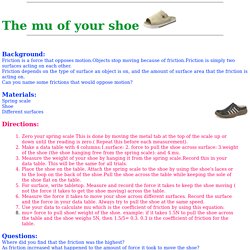

Friction: Crash Course Physics #6. How to measure friction? Introduction to the Coefficient of Friction. Coefficient of static friction. Intuition on static and kinetic friction comparisons. Mu of a Shoe Lab. The mu of your shoe- measuring friction. Background: Friction is a force that opposes motion.Objects stop moving because of friction.Friction is simply two surfaces acting on each other.

Friction depends on the type of surface an object is on, and the amount of surface area that the friction is acting on. Can you name some frictions that would oppose motion? Materials: Mu of Shoe - Textbook activity. The Win Tunnel: Shaved and Dangerous? Cycling training: how reducing your drag will improve your cycling performance. Cyclists need to understand aerodynamic drag in order to beat it.

Cycling coach Joe Beer gives the low-down on cycling aerodynamics and presents some of his own recently collected data. Although cyclists have to overcome the forces of gravity and the rolling resistance of tyres on roads/moving components on the bike, once your speed exceeds around 15mph, it’s aerodynamic drag that becomes your main enemy. Drag is a frictional force caused by the turbulence of displacing air that is pushed out of the way as you pass through it.
New Swimsuits Create Olympic Controversy. The high-tech swimwear that gives Olympic swimmers an edge. Top 5 olympic sports that have been influenced by technology. No 4 – Engineering Sport. Number 4 in our top 5 has been awarded to textile advances in swimming.

This is a fairly controversial inclusion; it is often used as an example of technological doping. I.e. cheating through the use of technology. However, looking back over the history of swimming, I’m almost 100% certain that none of the swimmers lining up on the united pools sides in London would have wanted to swap their scientifically designed outfit for an all in one woollen ensemble. Swimming has been in the Olympics since 1896. The primary function of the swimsuits in those early stages was modesty; the suits were typically knitted and covered the majority of the body (it was quite controversial for females in to display their upper legs in competition).
Speedo launches LZR RACER. Here's Why Some Olympic Swimmers Wear Two Swim Caps. Whether it's the type of bathing suit you wear, the way you jump off the diving board, or how much hair you have on your head, swimmers do a lot to make sure they get across the pool as fast as possible.

But you've likely never seen anyone wear two swim caps on their head at once. SB Nation noticed that when gold medal-winning Hungarian swimmer Katinka Hosszu took off her swim cap, she revealed that she had another one on beneath it: Getty Images She's not alone — other competitors such as Team USA swimmers Michael Phelps and Katie Ledecky, as well as China's gold medalist in the men's 200 meter freestyle, Sun Yang, all wear two caps when they compete. While it seems like any extra layers would slow a swimmer down, there's actually a really good explanation for it. Science of Golf: Why Golf Balls Have Dimples. The Incredible Hoop Glider! - ScienceBob.com. You will need A regular plastic drinking straw3 X 5 inch index card or stiff paperTapeScissors What to do Cut the index card or stiff paper into 3 separate pieces that measure 1 inch (2.5 cm) by 5 inches (13 cm.)Take 2 of the pieces of paper and tape them together into a hoop as shown.
Be sure to overlap the pieces about half an inch (1 cm) so that they keep a nice round shape once taped.Use the last strip of paper to make a smaller hoop, overlapping the edges a bit like before.Tape the paper loops to the ends of the straw as shown below. Are athletes really getting faster, better, stronger? Technology in Sport - Is it Cheating? Short Film - Graeme Obree, Athlete or Genius? Cycling's speed secrets.